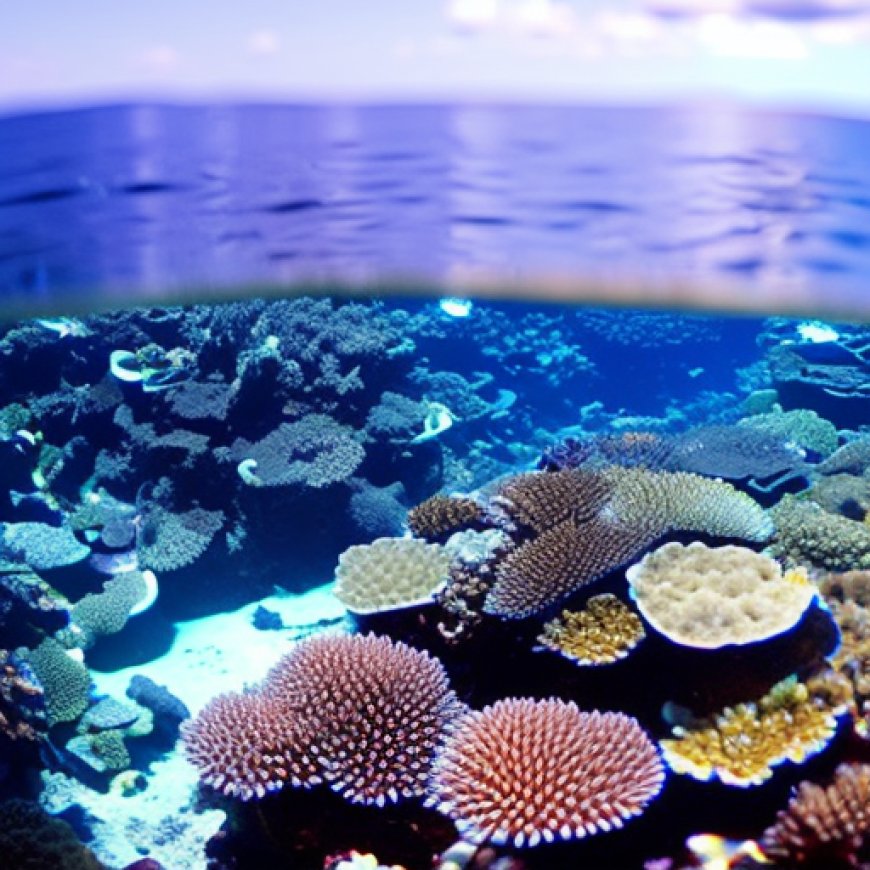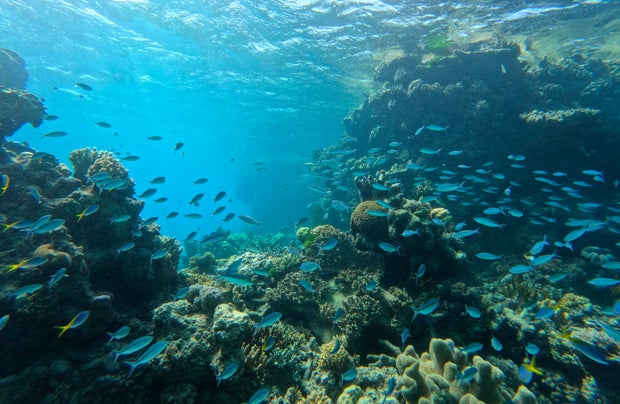Great Barrier Reef undergoing mass coral bleaching event for 5th time in nearly a decade
Great Barrier Reef undergoing mass coral bleaching event for 5th time in nearly a decade CBS News


The Great Barrier Reef Undergoing Fifth Mass Coral Bleaching Event
The Great Barrier Reef – the world’s largest reef system that’s “one of the richest and most complex natural ecosystems on Earth” – is once again undergoing a mass coral bleaching event. Officials said the event, the fifth occurrence in just under a decade, appears to be the result of heat stress after a record-breaking year for global temperatures.
Prevalent Coral Bleaching on Most Surveyed Reefs
Officials with the Australian government-run Great Barrier Reef Marine Park Authority said Friday their team conducted aerial surveys over two-thirds of the nearly 133,000-square-mile area. Those surveys “revealed prevalent shallow water coral bleaching on most surveyed reefs,” the park said, adding it’s “consistent with patterns of heat stress that has built up over summer.”
Global Impact of Climate Change on Coral Reefs
“This unfolding coral bleaching event follows similar reports from reefs around the world during the past 12 months,” the authority said in an update on its website. “These Northern Hemisphere reefs have suffered coral bleaching as a result of climate change-driven elevated ocean temperatures, amplified by El Niño conditions in the Pacific Ocean.”

Causes and Impact of Coral Bleaching
Coral bleaching can occur from stress caused by various reasons – temperature, light or nutrients. When the animals are stressed, the algae that live within their tissues as their primary food source, leaves. The algae also provide the coral with their usual vibrant color, which is why the animals turn white, or become bleached, when the algae leave.
Extent of Bleaching Event and Vulnerability of Coral
While the current event is widespread, its severity and depth vary throughout the surveyed parts of the reef system. The bleaching event’s true extent is unknown and will be evaluated through in-water research.

Importance of Protecting the Great Barrier Reef
The Great Barrier Reef is a UNESCO World Heritage Site, which the group calls a “globally outstanding and significant entity.” The system, which is bigger than the U.K., Switzerland and Holland combined — or roughly half the size of Texas — is “one of the richest and most complex natural ecosystems on Earth.” It contains a significant number of threatened species and is of enormous scientific and intrinsic importance.
Frequency of Coral Bleaching Events
The Great Barrier Reef has been plagued by mass bleaching events several times in the past two decades. According to the Great Barrier Reef Foundation, this marks the eighth event since 1998 and the fifth in just nine years. The most recent mass bleaching happened in 2022 during a La Niña summer, which the foundation said was “particularly concerning” as that weather phenomenon, unlike El Niño, “typically brings cooler, wetter conditions.”
Tackling Climate Change to Protect the Reef
Along with limiting fishing to help in the reef’s recovery, officials at the authority said the best action people can take is to tackle their role in the underlying issue – climate change. As global temperatures rise, largely from humans emitting planet-warming gases through the burning of fossil fuels, sea surface temperatures also rise. It’s the combination of local and global actions that will best enable the reef to tolerate and recover from events such as these.
Impact of Climate Change on the Great Barrier Reef
In the Great Barrier Reef, the average sea surface temperature has increased by more than 0.8 degrees Celsius since 1880, with the warmest years happening in the past two decades. Last month was the hottest February on record, with the oceans also seeing record highs.
Call to Protect Special Places and Biodiversity
“Climate change is the biggest risk, not just to the Great Barrier Reef in Australia, but also to coral reefs around the world,” said Australian Minister for the Environment and Water Tanya Plibersek. “We need to protect our special places and the plants and animals that call them home.”
SDGs, Targets, and Indicators
-
SDG 13: Climate Action
- Target 13.3: Improve education, awareness-raising, and human and institutional capacity on climate change mitigation, adaptation, impact reduction, and early warning.
- Target 13.2: Integrate climate change measures into national policies, strategies, and planning.
- Indicator 13.3.1: Number of countries that have integrated mitigation, adaptation, impact reduction, and early warning measures into primary, secondary, and tertiary curricula.
- Indicator 13.2.1: Number of countries that have communicated the strengthening of institutional, systemic, and individual capacity-building to implement adaptation, mitigation, and technology transfer.
-
SDG 14: Life Below Water
- Target 14.2: Sustainably manage and protect marine and coastal ecosystems to avoid significant adverse impacts.
- Target 14.5: By 2020, conserve at least 10% of coastal and marine areas.
- Indicator 14.2.1: Proportion of national exclusive economic zones managed using ecosystem-based approaches.
- Indicator 14.5.1: Coverage of protected areas in relation to marine areas.
Table: SDGs, Targets, and Indicators
| SDGs | Targets | Indicators |
|---|---|---|
| SDG 13: Climate Action |
|
|
| SDG 14: Life Below Water |
|
|
Analysis
1. Which SDGs are addressed or connected to the issues highlighted in the article?
The issues highlighted in the article are connected to SDG 13: Climate Action and SDG 14: Life Below Water.
2. What specific targets under those SDGs can be identified based on the article’s content?
Based on the article’s content, the specific targets that can be identified are:
- Target 13.3: Improve education, awareness-raising, and human and institutional capacity on climate change mitigation, adaptation, impact reduction, and early warning.
- Target 13.2: Integrate climate change measures into national policies, strategies, and planning.
- Target 14.2: Sustainably manage and protect marine and coastal ecosystems to avoid significant adverse impacts.
- Target 14.5: By 2020, conserve at least 10% of coastal and marine areas.
3. Are there any indicators mentioned or implied in the article that can be used to measure progress towards the identified targets?
Yes, there are indicators mentioned or implied in the article that can be used to measure progress towards the identified targets:
- Indicator 13.3.1: Number of countries that have integrated mitigation, adaptation, impact reduction, and early warning measures into primary, secondary, and tertiary curricula.
- Indicator 13.2.1: Number of countries that have communicated the strengthening of institutional, systemic, and individual capacity-building to implement adaptation, mitigation, and technology transfer.
- Indicator 14.2.1: Proportion of national exclusive economic zones managed using ecosystem-based approaches.
- Indicator 14.5.1: Coverage of protected areas in relation to marine areas.
Behold! This splendid article springs forth from the wellspring of knowledge, shaped by a wondrous proprietary AI technology that delved into a vast ocean of data, illuminating the path towards the Sustainable Development Goals. Remember that all rights are reserved by SDG Investors LLC, empowering us to champion progress together.
Source: cbsnews.com

Join us, as fellow seekers of change, on a transformative journey at https://sdgtalks.ai/welcome, where you can become a member and actively contribute to shaping a brighter future.







